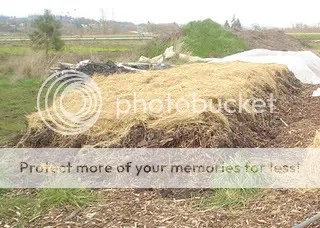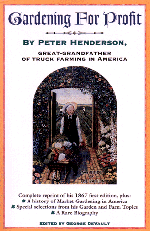Posts Tagged compost
March 22, 2008 at 10:57 pm · Filed under Notes ·Tagged compost, composting, farming, hot beds, hotbeds, organice farming, planting, sustainable agriculture
Notes based on Gardening for Profit (Chapter 9) by Peter Henderson.
Hotbeds are something we don’t see a lot of, despite their simplicity and usefulness. The idea is that compost generates heat, and seeds need heat to germinate. So why not put seeds directly on the compost pile (the “hot bed”) and coax those little buggers into making their debut a little early in the season? Henderson was doing this in the 1800s, and the logic still applies today:

This is a freshly made hotbed at Singing Pig Farm. It’s about 2 feet tall, 8 feet wide, and 40 feet long. (Disclaimer: I’m terrible at judging dimensions, so give or take about 20 feet on the width and length.) It’s topped with a layer of straw to level the surface and provide additional insulation. Under the straw is a rotting pile of leaves and grass clippings, courtesy of a landscaping company that was happy to get rid of it. The temperature in the pile when it was formed was 105 degrees Fahrenheit. Read the rest of this entry »
Permalink
February 4, 2008 at 10:01 pm · Filed under Notes ·Tagged compost, composting, guano, manure, soil fertility, soil preparation
Notes based on Gardening for Profit (Chapter 7) by Peter Henderson.
Back then when horses did all the work, there was lots of horse manure to be had. So Henderson took advantage of it and really piled it on.
At least six months before applying it, the manure was dumped in a natural depression. If there wasn’t one, they dug one out 18-24″ deep. They put up a 6′ fence around it. The wagons were pulled up next to the fence and fresh manure was tossed in, spread out evenly throughout the depression. Pigs were kept in the enclosure to break things up, and they were fed weeds and unsold vegetables from the field.
- I wonder how large this manure pit needed to be. I guess it depends on how much manure he needed, which depends on how much land he was preparing (he’d spread 50 to 100 tons per acre).
- Also, how many pigs? Two? Ten? That’s probably a function of field size and manure quantity, as well.
Henderson was a big fan of horse manure, and not just because it was plentiful. He considered it 1/3 more valuable than that of cattle and pigs, in terms of weight (i.e. 100 lbs of horse manure would work just as well as 130 lbs of cattle or pig manure). He also cites horse manure as being extra beneficial as a pulverizer on stiff soils. Read the rest of this entry »
Permalink
January 3, 2008 at 11:02 pm · Filed under To do ·Tagged compost, farming, soil fertility, soil health, soil organic matter, sustainable agriculture
OK, back to business. My plan had been to borrow a copy of The Biological Farmer by Gary Zimmer from the local university library. I’d been told it’s an excellent primer, and I’ve been looking for a source to provide me with a balanced context so I don’t get lost in the details. But before I could get my hands on a library copy, my schedule went to hell and now my “inside source” at the university has graduated. So then I was going to actually buy a copy, but tonight I came across another highly recommended book that’s available through the soil and health library nurtured by Steve Solomon (bless his heart). The book is Gardening for Profit by Peter Henderson and–get this–it was written and published in 1867! For a book to still be relevant and helpful over 200 years later [edit: 100 years later–math class, anyone?]…this I’ve got to read.
That library, by the way, it’s dangerous. There are so many goodies in there that I could easily blow a month’s paycheck in one sitting–I was so tempted to print out at least five books at once, but I practiced moderation and decided to print only one title, Gardening for Profit, at my local Fedex Kinko’s for $16. You can upload the PDF to their website and complete your order so that all you have to do is pick it up when it’s ready. I had my copy bound nicely so that it lasts a long, long time. I also paid the voluntary $15 to become a lifetime member of the soil and health library. Small price to pay for such a goldmine of knowledge!
Permalink
November 29, 2007 at 11:27 pm · Filed under Notes ·Tagged compost, farming, soil fertility, soil health, soil organic matter, sustainable agriculture
Found an abstract which might explain how excess N messes with soil carbon sequestration:
“The added NO3- suppressed mineralization of C from SOM and stimulated mineralization of C from stover. Adjustment of rates of stover decomposition to temperature regimes normally encountered in Iowa fields after harvest showed that stover decomposition would not be complete within 1 yr and that increases in NO3- availability decreased the amount of stover C remaining in the soil. This effect of NO3- could explain how additions of unneeded N could decrease concentrations of SOM in long-term studies in which residues and NO3- are added in annual cycles. These observations suggest that practices that reduce unnecessary fertilization could help conserve SOM and reduce net amounts of CO2 released to the atmosphere.”
Next: My pathetic attempt to translate this into understandable terms after reading the whole study, if I can get my hands on it.
Update: No luck finding the full study after searching two state university library systems. Here’s the citation for this article in case anyone’s interested:
Title: NITROGEN EFFECTS ON CONSERVATION OF CARBON DURING CORN RESIDUE DECOMPOSITION IN SOIL
Author(s): GREEN CJ, BLACKMER AM, HORTON R
Source: SOIL SCIENCE SOCIETY OF AMERICA JOURNAL 59 (2): 453-459 MAR-APR 1995
Permalink
November 28, 2007 at 11:58 pm · Filed under Notes ·Tagged compost, farming, soil fertility, soil health, soil organic matter, sustainable agriculture
Now that I’ve read the compost study, Albrecht’s article on soil restoration, and the nitrogen myth article, I’m still left wondering how nitrogen directly impacts the formation of organic matter. Albrecht insists that there must be adequate nitrogen present in the soil or else carbon is lost (presumably as carbon dioxide). The compost study results back this up – more nitrogen resulted in more soil carbon. But then the nitrogen myth article implies that excess nitrogen (and I mean extreme, as in 60-190% net addition of N) also results in the loss of carbon from the soil. How does this work?
C + Excess N = CO2
C + Too little N = CO2
C + Just the right amount of N = Soil carbon
I think I need to get my hands on a soil science/microbiology textbook. Maybe I’ll peruse eBay and find a cheap copy that some college student spilled their beer on.
Permalink
November 24, 2007 at 10:35 pm · Filed under Notes ·Tagged compost, farming, permaculture, soil fertility, soil health, soil studies, sustainable agriculture, william albrecht
My Albrecht studies continue with an article titled Loss of Soil Organic Matter and Its Restoration. Like The Drought Myth, it was packed with insights and information. The metaphors were especially striking. He referred to the soil as a breathing, working entity, like a factory where organic matter is fuel, bacteria is fire, and nitrogen is the building material of choice. It uses the equivalent of 1 horsepower per acre to burn organic matter, “exhaling” more than 25 times as much carbon dioxide per day as an adult man at work.
The organic matter (its supply of fuel) has been building up gradually for 25,000 years in North America, since a glacier receded and left minerals in its wake. Then came the pioneers who tilled the soil, and a steep decline in soil organic matter (SOM) began. With the loss of SOM came a proportionate decline in agricultural productivity, and the trend continues to this day (compensated for by chemical inputs, of course). In this article, Albrecht outlines ways in which this trend can be halted or even reversed. Read the rest of this entry »
Permalink
November 21, 2007 at 12:15 am · Filed under Notes ·Tagged compost, soil fertility, soil health, sustainable agriculture
Notes on: Improved compost mix great on the pad, but slow to deliver in the field – From NewFarm.org
This study was mostly inconclusive. There was so much variability between test plots that is was difficult to conclude much after just one year of research. Agronomic research must be a pain.
The only thing they could say, statistically speaking, is that poultry manure is awesome. Well, they didn’t quite say it that way. They said that poultry manure compost improved soil-carbon levels so much that they’re allowed to statistically say so, despite the crazy variability that prevents them from saying much else. Soil carbon generally translates into soil organic matter, and organic matter is awesome, thus poultry manure is awesome. They didn’t quite explain why it worked out that way, but I’ve heard through the grapevine that Albrecht knew why: Because you can’t retain carbon in your soil unless there’s enough nitrogen around to entertain it, and poultry manure is high in nitrogen. Read the rest of this entry »
Permalink


 Back to home page
Back to home page

 Save this page on Del.icio.us
Save this page on Del.icio.us